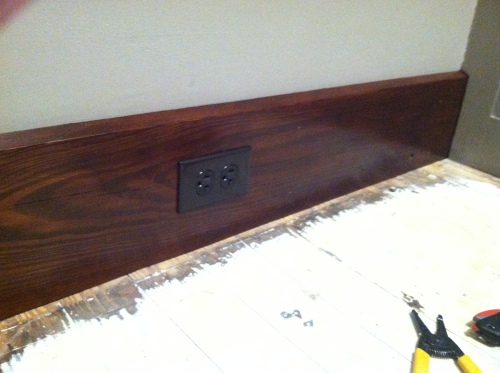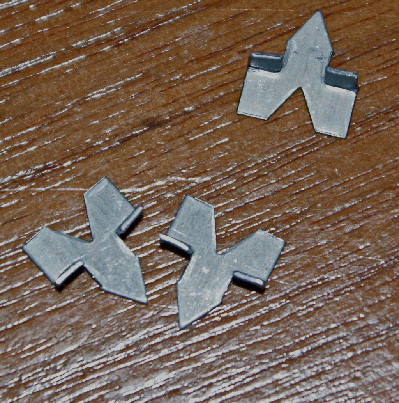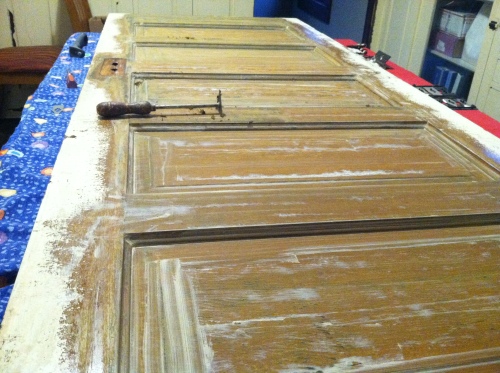Posts Tagged Painting
Room to Spare
Posted by Adam A. Ries in DIY, Home Improvement, Interior Design on May 29, 2016
Spare bedroom, that is.
Several months without a post. That doesn’t mean I haven’t been busy, just that I haven’t been working on my own home. In fact, in the last two months I’ve helped my brother-in-law with different aspects of their master bathroom remodel, and a partial remodel on my mother’s kitchen (reconfigured the existing base cabinets, installed a dishwasher, built additional base cabinets, and installed new countertop).
But sometime in between building cabinets in my unheated garage in the middle of an Ohio February, I finished painting the spare bedroom and nailed the window trim & baseboards back into place. Wow, did that make a difference!
 While reinstalling the baseboard, I added outlets to the perimeter of the bedroom through the baseboard. Each bedroom only had 1 original outlet to begin with. And I added the new outlets in the baseboard, just as the existing outlets were placed. I used brown outlet and outlet covers to help them disappear into the dark woodwork.
While reinstalling the baseboard, I added outlets to the perimeter of the bedroom through the baseboard. Each bedroom only had 1 original outlet to begin with. And I added the new outlets in the baseboard, just as the existing outlets were placed. I used brown outlet and outlet covers to help them disappear into the dark woodwork.

I already described the process of sanding & re-painting the wardrobe, and installing the light. Along with all new wiring, I can add this room to the 99% finished list along with the bathroom and laundry. (Like nearly every other room, the floor needs a few nails here and there to secure the boards, and then a whole-house floor refinishing party.)
Lastly, I found a door to fit at an architectural salvage store (the spare bedroom was door-less when I bought the house). It matches the bathroom door, but unfortunately was painted on one side. I spent the better part of 2 days stripping the paint – first white, then orange underneath.
It was the correct height, but actually just about 1/4″ too narrow. I glued & clamped a thin piece of pine to the hinge edge of the door, then with a hand plane and sandpaper made it flush with the sides of the door.
The other side was stained & varnished almost a matching color to my woodwork, so I just sanded off the finish and then re-stained both sides of the door to blend the color. It took 2 coats of stain on the freshly stripped side to get dark enough, then 2 coats of satin polyurethane. The piece I added to meet the right width is almost unnoticeable.
I’ve been collecting glass doorknobs when I find them inexpensively at antique stores or Goodwill, so I just had to buy the mortise latch threaded spindle – which I was pleasantly surprised to find they still sell at the hardware store. For me, there is nothing so rewarding as the feeling of putting the finishing touches on a completed project.

So now I begin the same process to the other bedroom, starting with stripping the woodwork and restoring the windows again.
Restoring Wood Windows – Putty, Prime, & Paint
Posted by Adam A. Ries in Home Improvement on January 10, 2016
Part 2 of restoring my home’s original wood windows. Part 1 is here.
Setting the glass means getting handsy with some glazing putty. Now some contractors say you can lay the glass into the rabbit using caulking or an adhesive. But I feel like that is a shortcut. The professionals who have been restoring windows for a while make a bed of the same putty that’s used on the outside of the glass, which is how wood windows would have been assembled originally 100 years ago. Recommended by all the pro’s, I use Sarco Glazing Putty, type M. I found it easy to work with, kind of like play dough. Working it like play dough for a minute or so with my hands makes it so much softer.

I lay an even thickness of putty along the rabbit on the inside the sash, using more than I need. I just move a ball of putty around the rabbit, pressing it in a few inches at a time with my palm. It’s a little messy, and it results in a lot of excess, but I wan’t squeeze out so that’s ok. Then I lay the glass on top. As carefully as I can, and often while holding my breath, I slowly work my hands around the perimeter of the glass, pressing firmly to set the glass into the putty. Also as carefully as I can, I use my glazing tool to press 2 or 3 glazing points into the groove on each side of the glass. I use these newer glazing points:

I think they are easier to set into place – and also because my first experience using the more original triangle glazier points resulted in slipping and cracking an original piece of glass, at which point I nearly gave up. (Instead I found an old glass window sash at a yard sale and was able to cut this piece of glass to fit.) The squeeze out putty can be scraped off and re-used, but using more than enough is important so that the glass makes a tight seal. Then I kind of repeat the process of pushing more putty into the rabbit with my palm, working my hand around the entire sash. I first use a glazing knife to simply push the putty tight into the groove, then it’s time time tool it smooth.
Tooling the putty is an art. Especially in the many videos online of professionals who can flawlessly tool an entire window in seconds. I spend a few minutes on each side of the glass, pressing the putty firmly into place while trying to achieve a smooth texture. Corners are a pain in the ass, I have yet to “master” a corner, but I’m getting better on each window.
Once the putty is tooled smooth – or as close as I can get it without losing my patience – I clean up the oily residue the putty leaves on the glass. This step is kind of fun, like painting only using a white powder called (what else), whiting. It’s the same whiting the professionals use, ordered online from the same company that sells the glazing putty. My understanding is that it’s pure limestone powder – it’s not cheap, but it goes a long way. With a very soft brush it really does clean the oil residue off of the glass that the putty leaves behind. It also skins the putty to encourage it to dry faster in prep for painting.
(I feel the need to insert here that yes, I have had to order many of these window restoration supplies and materials through the internet. The hardware stores around me don’t sell and can’t get many of these products. With as much time and energy I’m investing into these windows, I don’t want to substitute on inferior quality materials and take a chance of lessening how long these repairs last.)
Now onto painting – I’ve read a few different opinions, but the professionals I worked with said that using a good latex paint does not require priming the putty – the putty is manufactured to accept paint. For paint, I went by the recommendation of The Craftsman Blogger (an incredible resource for all things old house restoration!). Instead of a regular exterior latex, I went with Sherwin Williams’ Porch & Floor Enamel. It is a latex paint, but it is formulated to dry to a hard durable finish and unlike many latex paints, it doesn’t stick to other painted surfaces once cured.
I chose my paint colors for the outside of the window to stand out. Although I couldn’t tell the original color of the outside frames, while scraping paint from the sashes I could see that most original coat of paint was actually black. I love to see old houses with colorful window & frame combinations, and I really believe the “all white” or “all beige” window & trim combinations that plague so many homes is a negative result of the replacement window industry.

While scraping I found the original paint color to be black.
Although not black, I did choose a dark color for the sashes and a lighter color for the frames.
In my mind, I’m picturing a finished product something like this:
I had to work up an entire exterior color scheme before I could decide on paint colors, even though I’m quite awhile away from painting the outside of my house. But planning ahead, I was able to pinpoint the right colors for the outside of the windows. I decided on SW7069 Iron Ore for the sashes:
and SW 6105 Divine White for the window frames.
It looks more blue in this photo below, but in person its a deep navy/charcoal.
Now the secret to a long lasting window restoration? When painting the angled surface of the glazing putty, it is essential that the paint actually goes just a little bit onto the glass around the entire perimeter. Even if only 1/16 of an inch, lapping the paint onto the glass seals the putty to the glass and, from what I’ve read, makes the difference between a glazing job that lasts 5 years and one that lasts 25+ years. So many people finish their paint job with a glass scraper and scrape off the excess paint to make a perfectly clean line at the glazing putty. This ruins that seal the paint creates.
After 2 coats of paint, I wait a full week to make sure all the paint & putty is cured completely, then it’s time to put the windows back together. I bet I spent at least 3 weeks with each window tore apart. Like I said earlier, it’s all the waiting in between priming, glazing, and painting that takes the longest. Plus the fact that I get most of my work done on the weekends, so M-F of a full work week doesn’t see much progress either.
At this point I’m close to putting the window back together, but there are still a few more steps to ensure the window is air-tight. These include the original type of weatherstripping as well as 2 different types of modern weatherstripping.
The Lion, the Witch, and the Wardrobe
Posted by Adam A. Ries in DIY, Furniture, Home Improvement, Interior Design on January 8, 2016
Great book from my childhood. And the original BBC movie was the best back in the day. But for the title of this post, there actually is no witch. There is the Lion who thinks he owns my house, and keeps an eye on all my renovation projects:
And then the wardrobe:
I don’t think the wardrobe was originally here. Firstly, the baseboard in the room runs behind the wardrobe. Secondly, inside the wardrobe there was part of an inside door latch screwed into the floor – but it was against the back wall. And lastly, the wardrobe is almost the exact size of the opening that was unfinished in the bathroom when I first bought the house:
I actually think this wardrobe was inside the bathroom in this space. And that it wasn’t a doorway from this bedroom into the bathroom, but rather the wardrobe had doors on both sides. I did find spare doors in the rafters of my garage, but they don’t fit, so the mystery continues. Anyways, I plan to keep the wardrobe in the bedroom where I found it, but it needed a major overhaul.
So I removed the doors (I didn’t like the hinges anyways), and tore out the inside closet organizer too. The previous owner had glued melamine panels to each of the walls & ceiling inside, but I tore it out also – it wasn’t cut well, leaving unfinished corners throughout. Once removed, it revealed the plaster walls not in such great shape – and the adhesive tore the finish plaster off with it. So I beefed up the cabinet itself by screwing wood supports along each of the corners into the walls, and then nailing the frame of the cabinet to these cleats.
Rather than repair the plaster inside (not worth the time in my opinion), I took 2 sheets of underlayment and ripped them into 6″ planks and nailed them inside the closet to make it look like a wood lined closet. I used nickels as spacers to keep the planks in line.
The wardrobe was never varnished before it was painted, so sanding it down to bare wood would have been way too time consuming, and for a rather cheaply built cabinet, not worth the time. So I decided early on that I would just repaint it – but not blue. I did spend a bit of time sanding the cabinet and doors, since the previous coats of paint had drips, runs, and thick brush strokes. I painted the inside walls white, and the floor the dark color of the outside.

Apparently the original cabinet hinges in my house are impossible to find – every online restoration resource, eBay, and even architectural salvage shops – nothing. So I bought the most similar ones I could find to hang the wardrobe doors.
I’m even thinking of building some custom interior dividers to allow for 2 hanger bars, and maybe a few low shelves for shoes. But that’s not priority. To finish it off, I need to make a few pieces of cove crown molding for where it meets the ceiling, and also find some nice cabinet handles. But otherwise, I’m really happy with how it turned out.
 The wardrobe is Sherwin Williams Backdrop, and the walls are Morris Room Grey. Photographs don’t do justice to the color combo. To me, the colors are dark and light mushroom. Along with the rich mahogany stained woodwork, I feel like the room is an old-school study or library, very warm and masculine.
The wardrobe is Sherwin Williams Backdrop, and the walls are Morris Room Grey. Photographs don’t do justice to the color combo. To me, the colors are dark and light mushroom. Along with the rich mahogany stained woodwork, I feel like the room is an old-school study or library, very warm and masculine.
I even found a light fixture I liked and installed it this past weekend.
Next will be staining & varnishing the baseboards, wiring up the outlets, and this room will be finished. The lion seems to approve.




















